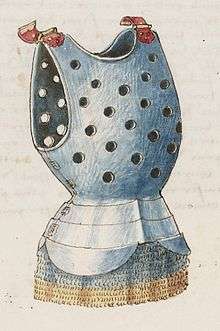Schynbalds

Schynbalds were an early experiment in plate armour for the lower leg. Schynbalds were metal plates strapped over chausses. Each schynbald was a single piece of steel that covered the front and outside of the shin. Schynbalds did not enclose the lower leg: hence, they were not true greaves. Schynbalds first appeared during the late thirteenth century and remained in use during the fourteenth and fifteenth centuries.[1]
Complete suits of armor survive only from the latter part of the schynbald era. In fifteenth century gothic armour they were strapped not to mail but to fastenings on a padded undergarment. By the early fifteenth century greaves had supplanted schynbalds in white armour. Schynbalds were essentially obsolete by the sixteenth century.
References
- ↑ Gravett, Christopher. English Medieval Knight 1200-1300. Oxford: Osprey Pub, 2002. Print.
